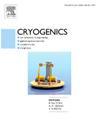氦亚大气压多级低温离心压缩机组的运行:第2部分-瞬态建模和泵降路径选择
IF 2.1
3区 工程技术
Q3 PHYSICS, APPLIED
引用次数: 0
摘要
在正常沸点(即4.2 K)以下运行氦低温系统所需的低压条件是通过一个通常称为“泵降”的瞬态过程建立的。这个过程被定义为从高于大气条件的压力到对应于特定工作温度的饱和压力的转变。frib2k系统由5台低温离心压缩机串联运行。从历史上看,泵降过程路径是通过经验方法和系统操作员经验建立的。FRIB对抽汲过程的调查旨在开发一种抽汲方法,该方法依赖于理论模型预测,而不是经验开发的过程路径。为了保证泵下过程的稳定运行,需要应用离心式压缩机性能预测模型,本文第1部分对此进行了介绍。压缩机性能图可以直接用于评估所选泵降路径的稳定性,并预测所选路径的整体可靠性。结合压缩机性能图,开发了一个系统压力模型来估计泵降过程中的瞬态压力响应。最后,建立了一个显式方程,建立了泵降过程的质量流量曲线。采用所提出的方法(包括开发的模型),系统操作员可以确定一个连续的泵降路径,以保持压缩机的稳定性,同时符合整个系统的能力。总的来说,所提出的方法简化了瞬态泵降作业,提高了泵降过程的可靠性、稳定性和效率。本文章由计算机程序翻译,如有差异,请以英文原文为准。
Operation of helium sub-atmospheric multistage cryogenic centrifugal compressor trains: Part 2 – Transient modeling and pump-down path selection
Low-pressure conditions required for operation of helium cryogenic systems below the normal boiling point (i.e. 4.2 K) are established through a transient process, commonly referred to as ‘pump-down’. This process is defined as the transition from pressures above atmospheric conditions to the saturation pressure which corresponds to a specified operational temperature. The FRIB 2 K system consists of five cryogenic centrifugal compressors which are operated in series. Historically, the pump-down process path has been established through empirical methods and system operator experience. Investigation into the pump-down process at FRIB aimed to develop a pump-down methodology which relies on theoretical model predictions rather than empirically developed process paths. Ensuring stable operation during the pump-down process involved application of a centrifugal compressor performance prediction model, which is described in Part 1 of this paper. Compressor performance maps can be directly used to evaluate the stability of a selected pump-down path and anticipate the overall reliability of the selected path. In conjunction with the compressor performance maps, a system pressure model was developed to estimate the transient pressure response during the pump-down process. Lastly, an explicit equation was developed to establish a mass flow rate profile for the pump-down process. Implementation of the presented methodology (including the developed models) allows for the system operator to determine a continuous pump-down path which maintains compressor stability while conforming to overall system capabilities. Overall, the methodology presented has resulted in simplification of transient pump-down operations and increased the reliability, stability and efficiency of the pump-down process.
求助全文
通过发布文献求助,成功后即可免费获取论文全文。
去求助
来源期刊

Cryogenics
物理-热力学
CiteScore
3.80
自引率
9.50%
发文量
0
审稿时长
2.1 months
期刊介绍:
Cryogenics is the world''s leading journal focusing on all aspects of cryoengineering and cryogenics. Papers published in Cryogenics cover a wide variety of subjects in low temperature engineering and research. Among the areas covered are:
- Applications of superconductivity: magnets, electronics, devices
- Superconductors and their properties
- Properties of materials: metals, alloys, composites, polymers, insulations
- New applications of cryogenic technology to processes, devices, machinery
- Refrigeration and liquefaction technology
- Thermodynamics
- Fluid properties and fluid mechanics
- Heat transfer
- Thermometry and measurement science
- Cryogenics in medicine
- Cryoelectronics
 求助内容:
求助内容: 应助结果提醒方式:
应助结果提醒方式:


